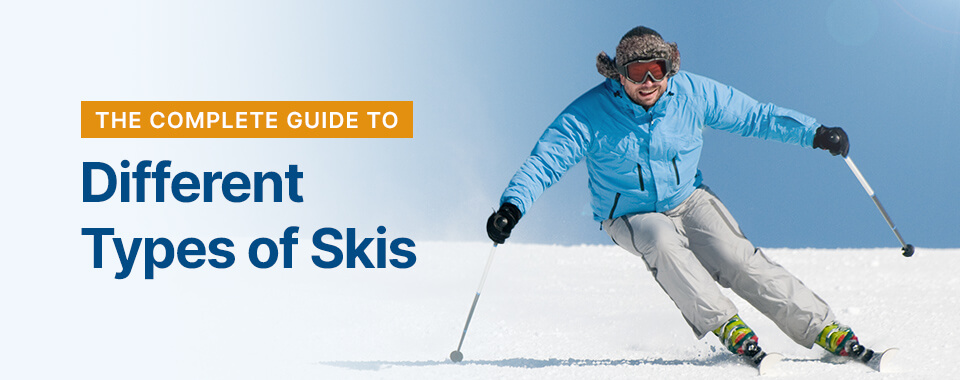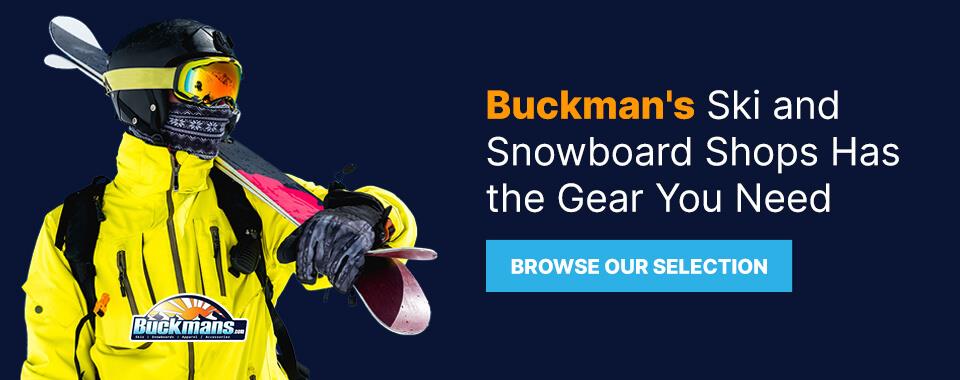 Guide to Different Types Of Skis
Guide to Different Types Of Skis
The Complete Guide to Different Types of Skis
Posted
by
Buckman's Ski & Snowboard Shops
on Monday, May 2, 2022
Whether you've recently started to explore the slopes or think of skiing as second nature, you may not be aware of how many ski variations exist. Each kind of ski has a distinct purpose, from helping you navigate the terrain to landing impressive tricks.
What are the different types of skis? If you're interested in purchasing your first pair of skis or trying a new skiing style, continue reading below to learn about the different ski brands available.
1. Racing Skis
Racing skis are ideal for precisely navigating quick turns at fast speeds. If you've ever watched skiers compete in slalom or giant slalom competitions, you've seen racing skis in action. For expert recreational skiers looking into racing skis, it's best to find non-FIS or World Cup race-stock models.
2. Freestyle Skis
When it's time to experiment with a few tricks, freestyle skis should be your go-to choice. Unlike standard skis, freestyle skis have lifted tips and tails, also known as twin tips, to accommodate skiing forward and backward. As a result, you can land easily after gliding on a rail or going off a jump.
3. Freeride Skis
Freeride skis are some of the best all-mountain skis to consider. These skis are typically a bit wider than all-mountain skis, making them ideal for traversing numerous kinds of skiing conditions. If you split your time between skiing groomed slopes and powder terrain, freeride skis may be a worthwhile investment.
4. Carving Skis
Unlike freestyle or all-mountain skis, carving skis are narrower skis that help you take sharp turns on groomed slopes. These skis are effective for increasing your speed, as well. Because of their design, they're better suited to more advanced skiers who can handle taking curves and going fast.
5. Big Mountain and Powder Skis
If you're interested in exploring a more adventurous side of skiing, you may be interested in checking out the backcountry — and hitting a few natural jumps along the way. Every skier who enjoys the challenge of trekking steep mountains only to jump off the cliffs at the bottom needs a pair of big mountain skis. These skis are longer and wider than other types of skis, helping you move through rugged powder and maintain control and speed.
Are you planning on exploring powder snow? If so, you could choose a pair of powder skis. This gear is ideal for navigating deep powder, even in the backcountry. One of the most crucial qualities of powder skis is their flotation, helping you glide across the powder thanks to their wide middles, or waists.
For powder skis, pick a women's pair with a width of 100 millimeters or more or a men's pair with a width of 109 millimeters or more.
6. All-Mountain Skis
People of all experience levels can use all-mountain skis. The sides and tips are designed to offer easy navigation and control, and high-end versions can meet experienced skiers' expectations. When you pit them against other kinds of skis, you'll note that they're the best all-around skis, as they work for groomed slopes and powder slopes alike.
When choosing a width, consider where you plan to ski most often. If you plan to mainly stay on groomed terrain, you should select all-mountain skis with a width of 85 millimeters. On the other hand, all-mountain skis up to 95 millimeters wide are best for skiing on groomed and powder slopes.
7. Backcountry Touring Skis
These skis are ideal for tackling the wild terrain of the backcountry. If you've trained extensively on groomed slopes and feel ready to explore off the beaten path, you should opt for a pair of backcountry or touring skis. These allow you to walk up hills and mountains so you can ascend to a good vantage point to ski down.
When selecting backcountry skis, you should consider the width you need for easy navigation. While a narrow pair of touring skis will be best for turning on hard snow, wider touring skis are ideal for powder. Pick a pair depending on the conditions where you plan to backcountry ski.
8. Cross-Country Skis
Anyone who enjoys a unique kind of adventure will enjoy cross-country skiing. Using cross-country skis allows you to ski or skate across a groomed or natural paths. This version of the sport offers a great way to explore the outdoors as you get a great workout.
Here's the difference between both types of cross-country skis.
- Cross-country touring skis: These skis allow you to move down a trail in a forward and backward stride, as they're narrow, long and easy to maneuver.
- Cross-country skate skis: If you prefer to travel across trails in a speed-skating motion, you should use skate skis. These are much shorter, skinnier and stiffer than traditional skis.
Questions to Ask When Choosing the Right Type of Skis
As you're deciding among skis, you may want to ask yourself the following questions.
Where Do I Plan to Ski Most Often?
The kind of terrain you ski on most often will make a significant difference in your decision.
If you prefer to hit the groomed slopes at your local ski resort, you'll want to pick up a pair of freeride skis. On the other hand, skiers who want to spend their time at terrain parks will want to invest in a pair of freestyle skis. Those who hang out in the backcountry require big mountain, touring or powder skis.
Of course, you can always trade in your existing pair of skis or grab a new pair of skis when your habits change or you want to try new kinds of skiing.
What's My Experience Level?
Those in the skiing world typically refer to experience levels in three groups. These groups correspond with the kinds of terrain you can safely and confidently traverse at a ski resort and are marked with green, blue and black signs.
- Green zone skiers: Beginner
- Blue zone skiers: Intermediate
- Black zone skiers: Advanced
If you've never skied before only going on the easiest green slopes, you should use short, lightweight skis that can help you learn the most basic skiing techniques. As you advance, you can start using longer, wider skis that your growing skill level allows you to control when navigating tight paths and higher speeds. Advanced skiers will want to branch out to specialized kinds of skis, like big mountain skis or racing skis.
What Size Skis Do I Need?
In general, the length of your skis will depend on your height and experience level. Remember, beginner skiers will want shorter skis. For example, a 5'8" person will want to begin with skis that are 160 centimeters long. As they progress, they'd upgrade to longer skis depending on their skill level and where they ski.
Regarding width, you'll want to think about the activities you're planning on doing. The waist of your skis will impact how you control them — narrow skis are best for gliding down groomed runs, and wide skis are ideal for navigating deeper powder.
Length will also be dictated by the amount of rocker a ski has. The rocker is the design on the end of the skis that makes them rock back and forth, allowing you to float and turn more easily in the snow.
If you have questions about how your weight, skiing style or other individual variables impact the size you should get, it's best to speak with a professional at your local ski shop about the different sizes of skis.

Buckman's Ski and Snowboard Shops Has the Gear You Need
Buckman's Ski and Snowboard Shops is your go-to winter sports headquarters for all things skiing and snowboarding. If you can't decide which kind of skis are best for you, our friendly, knowledgeable team is here to help you make an informed choice. With decades of experience, Buckman's can help you find the gear you need to fuel your curiosity and passion.
Browse our wide selection of ski equipment today! If you have questions, reach out to our award-winning customer service team — we're ready to help.
Categories:
Ski equipment